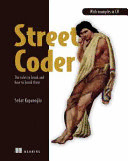Table Of ContentWith examples in C#
The rules to break and
how to break them
Sedat Kapanog˘lu
M A N N I N G
Impact of complexity on performance
Search algorithm Complexity Time to find a record among 60 rows
The DIY quantum computer Lisa’s uncle has in his garage O(1) 1 second
Binary search O(log N) 6 seconds
Linear search (because your boss asked you to do it an O(N) 60 seconds
hour before the presentation)
The intern accidentally nested two for loops. O(N2) 1 hour
Some randomly pasted code from Stack Overflow that also O(2N) 36.5 billion years
finds a solution to some chess problem while searching,
but the developer didn’t bother to remove that part.
Instead of finding the actual record, the algorithm tries to O(N!) The end of the universe, but still
find the arrangement of records that spell out the record before those monkeys finish their
you’re looking for when sorted in a certain way. The good so-called Shakespeare
news is that the developer doesn’t work here anymore.
Street Coder
T
HE RULES TO BREAK AND HOW TO BREAK THEM
SEDAT KAPANOĞLU
MANNING
SHELTER ISLAND
For online information and ordering of this and other Manning books, please visit
www.manning.com. The publisher offers discounts on this book when ordered in quantity.
For more information, please contact
Special Sales Department
Manning Publications Co.
20 Baldwin Road
PO Box 761
Shelter Island, NY 11964
Email: [email protected]
©2022 by Manning Publications Co. All rights reserved.
No part of this publication may be reproduced, stored in a retrieval system, or transmitted, in
any form or by means electronic, mechanical, photocopying, or otherwise, without prior written
permission of the publisher.
Many of the designations used by manufacturers and sellers to distinguish their products are
claimed as trademarks. Where those designations appear in the book, and Manning
Publications was aware of a trademark claim, the designations have been printed in initial caps
or all caps.
Recognizing the importance of preserving what has been written, it is Manning’s policy to have
the books we publish printed on acid-free paper, and we exert our best efforts to that end.
Recognizing also our responsibility to conserve the resources of our planet, Manning books are
printed on paper that is at least 15 percent recycled and processed without the use of elemental
chlorine.
The author and publisher have made every effort to ensure that the information in this book
was correct at press time. The author and publisher do not assume and hereby disclaim any
liability to any party for any loss, damage, or disruption caused by errors or omissions, whether
such errors or omissions result from negligence, accident, or any other cause, or from any usage
of the information herein.
Manning Publications Co. Development editors: Toni Arritola and Becky Whitney
20 Baldwin Road Technical development editor: Frances Buontempo
PO Box 761 Review editor: Aleksandar Dragosavljevic´
Shelter Island, NY 11964 Production editor: Keri Hales
Copy editor: Suzanne G. Fox
Proofreader: Katie Tennant
Technical proofreader: Orlando Méndez Morales
Typesetter: Gordan Salinovic
Cover designer: Marija Tudor
ISBN 9781617298370
Printed in the United States of America
To my brother Muzaffer,
who introduced me to the fantastic world of computers
brief contents
1 ■ To the streets 1
2 ■ Practical theory 14
3 ■ Useful anti-patterns 53
4 ■ Tasty testing 94
5 ■ Rewarding refactoring 122
6 ■ Security by scrutiny 140
7 ■ Opinionated optimization 171
8 ■ Palatable scalability 198
9 ■ Living with bugs 222
v
contents
preface xiii
acknowledgments xv
about this book xvii
about the author xx
about the cover illustration xxi
1 To the streets 1
1.1 What matters in the streets 2
1.2 Who’s a street coder? 3
1.3 Great street coders 4
Questioning 5 ■ Results-driven 5 ■ High-throughput 6
Embracing complexity and ambiguity 6
1.4 The problems of modern software development 7
Too many technologies 8 ■ Paragliding on paradigms 9
The black boxes of technology 10 ■ Underestimating
overhead 11 ■ Not my job 11 ■ Menial is genial 11
1.5 What this book isn’t 12
1.6 Themes 12
vii
viii CONTENTS
2 Practical theory 14
2.1 A crash course on algorithms 15
Big-O better be good 17
2.2 Inside data structures 19
String 20 ■ Array 23 ■ List 24 ■ Linked list 25
Queue 26 ■ Dictionary 26 ■ HashSet 29 ■ Stack 29
Call stack 30
2.3 What’s the hype on types? 30
Being strong on the type 31 ■ Proof of validity 32 ■ Don’t
framework hard, framework smart 37 ■ Types over typos 40
To be nullable or non-nullable 41 ■ Better performance for
free 47 ■ Reference types vs. value types 49
3 Useful anti-patterns 53
3.1 If it ain’t broke, break it 54
Facing code rigidity 54 ■ Move fast, break things 55
Respecting boundaries 56 ■ Isolating common functionality 57
Example web page 59 ■ Leave no debt behind 60
3.2 Write it from scratch 61
Erase and rewrite 61
3.3 Fix it, even if it ain’t broke 62
Race toward the future 62 ■ Cleanliness is next
to codeliness 64
3.4 Do repeat yourself 66
Reuse or copy? 70
3.5 Invent it here 71
3.6 Don’t use inheritance 74
3.7 Don’t use classes 76
Enum is yum! 76 ■ Structs rock! 78
3.8 Write bad code 83
Don’t use If/Else 83 ■ Use goto 85
3.9 Don’t write code comments 88
Choose great names 90 ■ Leverage functions 90

